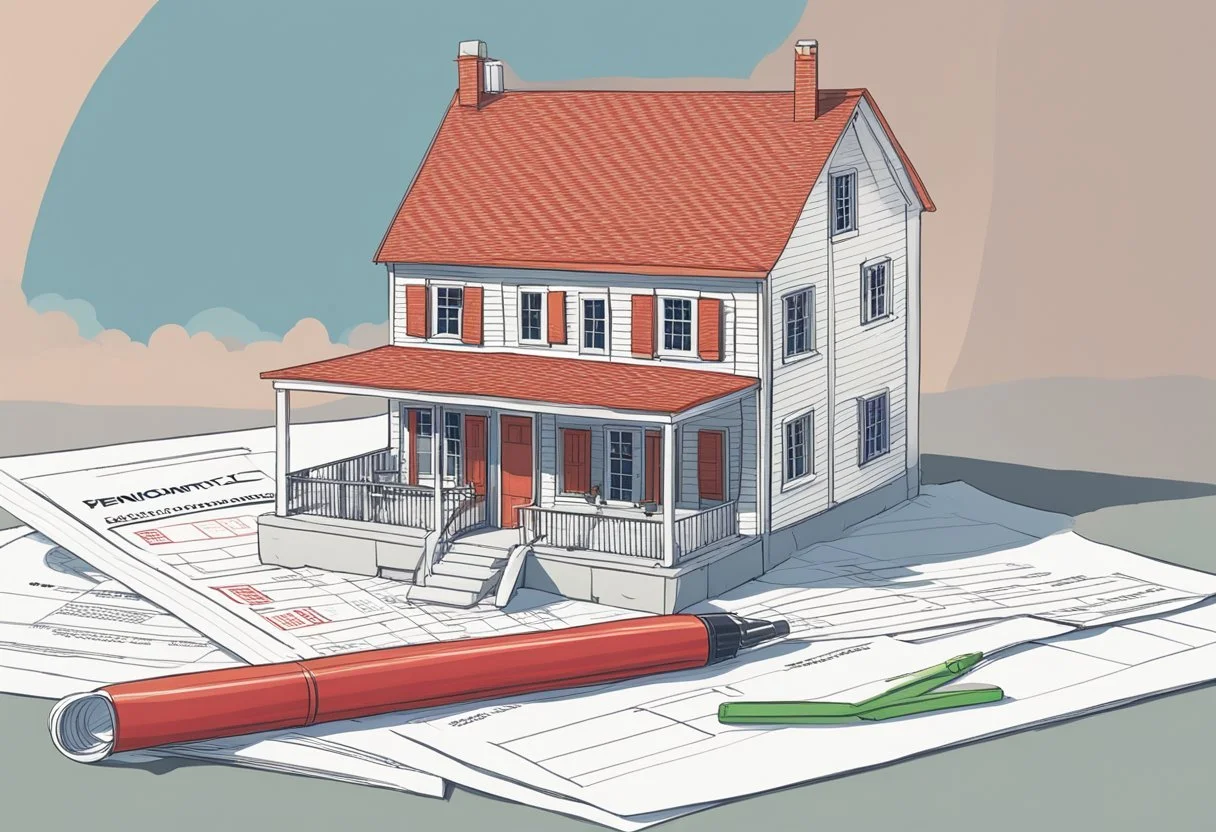Vermont Homestead Exemption
Key Benefits and Eligibility Requirements
This article is part of our guide on the Homestead Exemption by State
The Vermont homestead exemption is a vital legal provision that offers protection and financial relief to homeowners in the event of economic hardship or unforeseen circumstances. By safeguarding a portion of a homeowner's primary residence from creditors, the exemption ensures that individuals and families can maintain a sense of security and stability amidst challenging times. This policy aims to provide a foundational understanding of the Vermont homestead exemption, its benefits, and eligibility requirements.
In the state of Vermont, the homestead exemption allows homeowners to protect the equity in their primary residence up to a certain amount, which is subject to change and determined by state legislation. The primary objective of this exemption is to prevent creditors from forcing the sale of a person's home in order to satisfy outstanding debts. Consequently, this offers a certain level of protection to homeowners who may be experiencing financial distress or facing bankruptcy.
The Vermont homestead exemption is applicable to various types of properties, including single-family homes, condominiums, and mobile homes that are classified as a homeowner's primary residence. To qualify for the exemption, individuals must meet specific criteria, which include ownership and residency requirements, as well as staying current with property tax payments. It is crucial for homeowners to be aware of these stipulations to take full advantage of the protection offered by this exemption.
Understanding Vermont Homestead Exemption
Definition of a Homestead
A homestead in Vermont refers to a residential property that is owned and used as the primary residence by an individual. This real property can include land, buildings, or a combination of both. Vermont homestead exemption allows eligible homeowners to protect a certain amount of equity in their property from creditors' claims and property taxes.
Homestead Declaration
To benefit from Vermont homestead exemption, property owners must file a Homestead Declaration. The process involves completing a form provided by the Vermont Department of Taxes, which includes information about the property and its use. Once filed, the property is designated as a homestead, and the exemption becomes applicable.
Filing a Homestead Declaration is essential as it:
Ensures that the property is taxed at the homestead tax rate, which is typically lower than the nonhomestead rate.
Protects a portion of the property's value from creditors, in case of bankruptcy or other financial difficulties.
It's important to file the declaration annually, as it is not automatically renewed.
Distinguishing Homestead from Nonhomestead Property
There are notable distinctions between homestead property and nonhomestead property in Vermont. The primary factors for differentiating between the two are ownership and use of the real property:
Examples of nonhomestead properties include:
Second homes
Holiday cottages
Rental properties
Commercial properties
By filing a Homestead Declaration and understanding the differences between homestead and nonhomestead properties, Vermont residents can effectively protect their primary residence from financial complications and benefit from reduced property tax rates.
Eligibility Criteria for Homestead Exemption
Requirements for Vermont Residents
Eligibility for homestead exemptions in Vermont primarily depends on a few essential factors. First and foremost, claimants must be Vermont residents. They should also own and occupy the property as their principal dwelling on April 1 of the tax year. If the property is leased, the lessee must possess a written agreement that states the lessee is responsible for the property tax payment.
Age Considerations for Claimants
Another critical factor in the eligibility criteria is the age of the claimant. Claimants must be at least 62 years old to qualify. Additionally, if the property is co-owned by a spouse or civil union partner, only one person needs to meet the age requirement.
Special Cases: Trusts and Life Estates
Certain specific cases, such as trust ownership and life estates, also impact the eligibility for homestead exemptions in Vermont.
Trust Ownership: Claimants with properties held in trust can still qualify for the exemption. If the owner is a beneficiary of the trust, they should be occupying the property as their primary dwelling. For irrevocable trusts, the beneficiary must have a legal interest or a right to possession for life.
Life Estates: Homestead exemption is available for properties with a life estate arrangement. In this case, the life tenant, or the person who holds the life estate, should be occupying the property as their primary dwelling.
Filing Process and Documentation
Accessing and Completing Form HS-122
To claim the Vermont homestead exemption, taxpayers must file a homestead declaration with Form HS-122. This form can be accessed online through the Vermont Department of Taxes' online system, MyVTax. To get started, create an account or log in to your existing MyVTax account. Once logged in, navigate to the "File a Homestead Declaration" section and follow the instructions provided.
Alternatively, you can obtain a paper copy of Form HS-122 from the Vermont Department of Taxes office or download and print it from their website. When completing the form, make sure to provide accurate information, including your name, Social Security number, and property details.
Understanding Schedule HI-144
Schedule HI-144, or the Household Income Schedule, must be completed and submitted along with Form HS-122 to determine eligibility for the property tax credit claim. This form calculates your household income by considering your Vermont income tax information, as well as other sources of income.
When completing Schedule HI-144, provide the following details:
Vermont income tax filing status and taxable income.
Social Security benefits and other non-taxable income.
Business, farm, and rental income.
Dependent and spousal exemptions.
After completing Schedule HI-144, attach it to your income tax return or file it with Form HS-122, if not required to file an income tax return.
Property Tax Credit Claim Filing
If you're eligible for a Property Tax Credit Claim, submit it along with your Homestead Declaration (Form HS-122) and Household Income Schedule (HI-144) by the annual deadline, typically April 15th. You can file everything together online through MyVTax, or mail paper forms to the Vermont Department of Taxes.
Keep in mind that if you have a balance due on your Vermont Income Tax Return, you must use Form HS-122W to request that your property tax credit claim be applied to your income tax balance. This form is available on the Vermont Department of Taxes website and can also be completed online through MyVTax.
By following these steps and adhering to the filing deadlines, Vermont residents can confidently and accurately claim their homestead exemption and property tax credit.
Tax Implications and Benefits
Calculating Housesite Value
The Vermont homestead exemption aims to provide relief to homeowners by potentially reducing their property tax burden. A critical aspect of this process is calculating the housesite value, which determines the eligible tax benefits. The housesite value consists of the property's land and the dwelling that serves as the primary residence.
To calculate the housesite value, it is essential to consider the fair market value of the property and, if applicable, apply the homestead exemption. The exemption amount can vary, so consult your local tax jurisdiction for accurate information.
Household Income and Tax Credits
Household income plays a crucial role in determining the eligibility for tax credits on Vermont homestead exemptions. The tax credit calculation depends on both the taxpayer's household income and the homestead education property tax rate. If the household's annual income is below a certain threshold (e.g., $47,000), homeowners may qualify for a property tax credit.
The property tax adjustment claim allows eligible homeowners to apply for this credit, which can lead to a decrease in the total housesite education tax owed. Note that the Vermont Department of Taxes holds the authority to adjust the income eligibility threshold annually.
Education and Municipal Taxes
Understanding the relationship between Vermont's homestead exemption and education property taxes is crucial. The homestead education property tax rate is applied to the housesite value, impacting both education and municipal taxes.
Housesite Education Tax: The tax adjustment results in a decrease in the housesite education tax. This affects the contribution a homeowner makes to their local education fund and is directly proportional to their adjusted housesite value.
Housesite Municipal Tax: The municipal tax is calculated by applying the homestead municipal tax rate to the housesite value. Although the homestead exemption does not directly impact the municipal tax rate, a lower housesite value might result in reduced municipal tax obligations.
Finally, it is essential to remember that the Vermont homestead exemption and associated tax implications may vary by jurisdiction and the homeowner's individual circumstances. Be sure to consult your local tax office or a tax professional for personalized advice related to the Vermont homestead exemption and tax benefits.
Ownership and Usage Criteria
Determining Ownership Percentage
In Vermont, the homestead exemption helps protect a homeowner's principal residence by providing it with an exemption from certain property taxes. To determine the eligibility of a property for this exemption, the ownership percentage plays a crucial role. The ownership percentage is the portion of the property owned by the individual claiming the exemption.
For instance, if a person owns 100% of a property, they can claim the full exemption. Conversely, if they own only 50% of the property, they can claim only half of the exemption. It is essential to understand and establish the ownership percentage accurately to ensure that the proper exemption is applied to the property.
Rental Properties and Usage
When it comes to rental properties, the usage of the property significantly impacts the homestead exemption eligibility. In Vermont, the principal residence is the primary factor determining if a property qualifies for this exemption. A principal residence refers to the place where an individual resides for the majority of the year and has a legal domicile.
If the property is rented or used for other purposes, it may not qualify for the full exemption. A property owner should calculate their rental use percentage, which represents the portion of the property used for rental or non-residential purposes. For example:
To calculate the exemption amount for a property with mixed usage, the rental use percentage must be subtracted from the total exemption available. In doing so, the property owner ensures that the exemption is only applied to the portion of the property that serves as their principal residence.
Determining the correct ownership percentage and assessing rental properties' usage is vital in accurately calculating the homestead exemption for a property in Vermont. Being aware of these criteria helps homeowners benefit from the exemption as intended and avoid potential issues surrounding property tax obligations.
Deadlines and Penalties
Filing Deadline for Homestead Declaration
The filing deadline for Vermont Homestead Declaration (Form HS-122) is typically on April 15th of each year. However, if this date falls on a weekend or a federal holiday, the deadline may be extended to the next business day. It is crucial for Vermont homeowners to be aware of this deadline and ensure they file their declaration on time to avoid penalties and interest charges.
Consequences of Late or Incorrect Filing
Failing to file the Homestead Declaration by the deadline or filing it with incorrect information can result in both penalties and interest charges that can be financially burdensome for the homeowner. The consequences of late or incorrect filing are outlined below:
Late Filing Penalty: If you miss the filing deadline, a late filing penalty of 3% of the education property tax is assessed on your homestead. This penalty is capped at a maximum of $15,000.
Incorrect Information Penalty: If you submit incorrect information on your declaration, you may be assessed a penalty of up to 1% of the education property tax on your homestead.
Interest Charges: On top of any penalties that may be assessed, interest is also charged on any unpaid education property taxes as a result of late or incorrect filing. The interest rate is set annually by the Vermont Department of Taxes.
To avoid these consequences, it is essential to file your Homestead Declaration accurately and timely. Be sure to double-check property information and keep an eye on the filing deadline each year. By being proactive and responsible, you can ensure that your Vermont homestead exemption is properly utilized, and these penalties and interest charges are avoided.
Special Situations
Homesteads Owned by Farmers
Farmers in Vermont may qualify for the homestead exemption, which can reduce their tax obligations. A farmer is described as an individual or a farm corporation that generates at least $10,000 in gross income from agricultural activities per year. To qualify for the exemption, the farm property must be the primary residence of the farmer.
If a farm corporation owns the homestead, the majority of shares must be held by Vermont residents with a dependency on the farm's earnings. Meeting these requirements allows farmers to claim the homestead exemption on their property and potentially lower their tax burden.
Renter Rebate Claims
Vermont residents who rent their living premises can also benefit from the homestead exemption through the Renter Rebate program. This program issues a refund to eligible renters who have occupied a rental property as their primary residence for more than six months of the taxable year. To qualify, the renter must:
Be a Vermont resident for the full tax year
Be financially dependent on the rental property
Not receive any other type of homestead exemption or benefit from the property
The Renter Rebate program offers a valuable opportunity for Vermont renters to receive a tax refund on their rental property expenses.
Addressing Common Issues
Various issues may arise when Vermont residents file for homestead exemptions or renter rebate claims. Some of the most common issues include:
Inaccurate homestead declaration: Ensure that all information provided on the property is accurate, including the property's fair market value and parcel ID number.
Late filing: To receive the homestead exemption or renter rebate, individuals must file their declarations on time. Late filings may result in delayed benefits or penalties.
Missed exemptions or rebates: Keep track of the eligibility requirements for both programs to avoid missing out on potential benefits. This includes understanding the dependency relationships and income limitations for farmers and renters.
Being aware of these common issues can help Vermont residents proactively address them and maximize their homestead exemption benefits.







